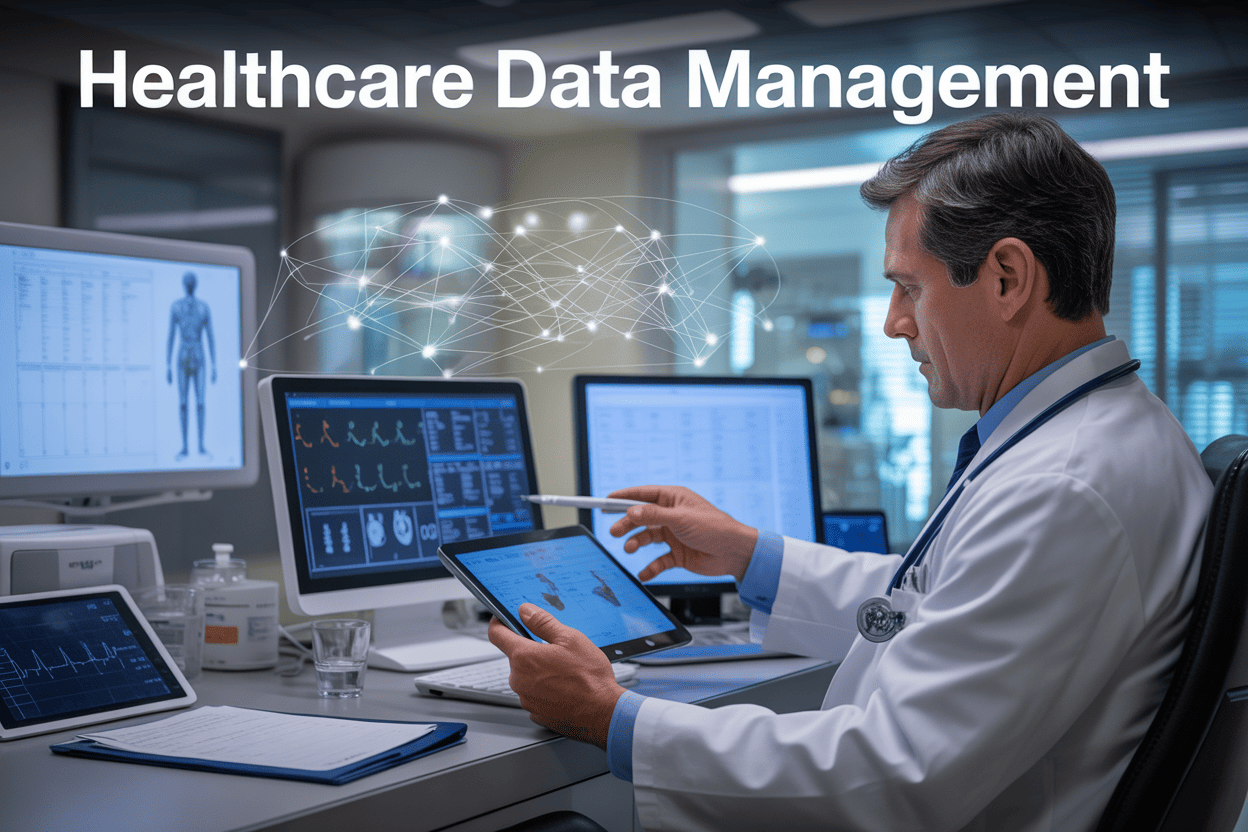Healthcare organizations face mounting pressure to manage vast amounts of patient information while maintaining accuracy and efficiency. Healthcare data management has become a critical foundation for delivering quality care, reducing operational costs, and meeting regulatory requirements in today’s digital healthcare landscape.
This comprehensive guide serves healthcare administrators, IT professionals, and clinical leaders seeking to optimize their organization’s data handling capabilities. Healthcare provider data management strategies can transform how medical facilities operate, from patient intake to treatment outcomes.
The following sections explore three essential areas: understanding modern healthcare data management systems and their core components, eliminating data silos through centralized solutions that connect departments seamlessly, and enhancing patient care through accurate information that supports clinical decision-making. These topics provide actionable insights for organizations ready to streamline their data operations and improve overall healthcare delivery.
Understanding Healthcare Data Management Systems
Define Comprehensive Data Management Frameworks
Healthcare data management frameworks serve as the backbone for organizing, storing, and accessing critical patient information across medical facilities. These comprehensive systems encompass electronic health records (EHRs), practice management software, laboratory information systems, and imaging databases that work together to create a unified data ecosystem.
Modern healthcare provider data management frameworks operate on standardized protocols like HL7 FHIR and DICOM, ensuring seamless data exchange between different platforms and vendors. The framework architecture typically includes data governance policies, security protocols, backup procedures, and user access controls that maintain data integrity while enabling authorized personnel to retrieve information quickly.
Successful frameworks also incorporate data quality management processes that validate, cleanse, and standardize incoming information. This includes automated error detection, duplicate record identification, and real-time data verification systems that prevent inconsistencies from propagating throughout the network.
Identify Key Components of Modern Healthcare Databases
Contemporary healthcare databases consist of several interconnected components that handle different aspects of patient care and administrative operations. The core components include patient demographics databases, clinical documentation systems, billing and insurance databases, pharmacy management systems, and scheduling platforms.
| Component Type | Primary Function | Data Storage Focus |
|---|---|---|
| Clinical Database | Medical records management | Diagnoses, treatments, and lab results |
| Administrative Database | Operational workflows | Scheduling, billing, and insurance |
| Analytics Database | Performance tracking | Quality metrics, outcomes data |
| Imaging Database | Medical imaging storage | X-rays, MRIs, CT scans |
Patient data repositories store comprehensive medical histories, including allergies, medications, previous procedures, and family medical backgrounds. Clinical decision support databases contain evidence-based treatment protocols, drug interaction information, and diagnostic guidelines that assist healthcare providers in making informed decisions.
Administrative components manage appointment scheduling, resource allocation, staff credentials, and financial transactions. These systems track patient visits, process insurance claims, generate invoices, and maintain compliance documentation required for regulatory reporting.
Explore Integration Capabilities Across Departments
Data management in healthcare requires seamless integration between various departments to eliminate communication gaps and reduce medical errors. Modern systems connect emergency departments, surgical units, laboratories, radiology, pharmacy, and billing departments through centralized data sharing protocols.
Real-time integration capabilities enable instant access to patient information regardless of which department initially collected the data. Emergency room physicians can immediately view laboratory results ordered by primary care providers, while surgeons access current medication lists updated by pharmacy staff.
Application programming interfaces (APIs) facilitate smooth data flow between different software systems, allowing departments to maintain their specialized tools while contributing to the comprehensive patient record. Cloud-based integration platforms enable remote access and multi-location data sharing, supporting healthcare networks with multiple facilities.
The integration extends beyond internal departments to include external partners like specialist offices, diagnostic centers, insurance companies, and public health agencies. This connectivity supports care coordination, reduces duplicate testing, and improves overall treatment outcomes.
Analyze Scalability Requirements for Growing Practices
Healthcare data management systems must accommodate rapid growth in data volume, user numbers, and processing demands as practices expand their services and patient populations. Scalability planning involves assessing current storage capacity, network bandwidth, processing power, and user access requirements.
Cloud-based solutions offer elastic scalability that automatically adjusts resources based on demand fluctuations. Practices can start with basic configurations and seamlessly upgrade processing power, storage capacity, and user licenses as needs evolve. This approach eliminates the need for large upfront investments in hardware infrastructure.
Database partitioning strategies help manage growing data volumes by distributing information across multiple servers while maintaining query performance. Horizontal scaling adds additional servers to handle increased workloads, while vertical scaling upgrades existing hardware components.
Growing practices also need scalable security measures that can accommodate new users, devices, and access points without compromising data protection. Role-based access controls, multi-factor authentication, and automated monitoring systems must expand alongside the organization while maintaining regulatory compliance standards.
Eliminating Data Silos Through Centralized Solutions
Break down departmental information barriers
Healthcare organizations often struggle with fragmented data scattered across multiple departments, creating invisible walls that prevent efficient information flow. Radiology stores imaging data in one system, laboratory results sit in another database, and pharmacy records exist independently. This fragmentation forces healthcare professionals to waste valuable time searching for patient information across multiple platforms, leading to delays in treatment decisions and potential gaps in care coordination.
Breaking down these barriers requires a systematic approach to healthcare provider data management that connects previously isolated systems. When departments can access shared information pools, medical teams gain a complete picture of patient health status without the frustration of system-hopping. Emergency departments benefit tremendously from immediate access to a patient’s surgical history from orthopedics, while cardiology teams can quickly review recent laboratory values without calling multiple departments.
The transformation begins by identifying which departments hold critical patient information and mapping the current data flow patterns. Organizations typically discover that nursing units, specialty clinics, and diagnostic departments each maintain separate record-keeping practices. Creating bridges between these information islands eliminates redundant data entry and reduces the risk of transcription errors that occur when staff manually transfer information between systems.
Create unified patient record accessibility
Modern healthcare demands that patient records become universally accessible across all care settings within an organization. A unified approach to data management in healthcare ensures that every authorized healthcare professional can access comprehensive patient information from any location within the facility network. This accessibility transforms how medical teams collaborate and make treatment decisions.
Unified patient records combine clinical notes, diagnostic results, medication histories, and care plans into a single, searchable interface. Physicians can review a patient’s complete medical timeline during consultations, while nurses access real-time medication administration records to prevent drug interactions. The system maintains data integrity by automatically updating information across all access points when changes occur.
The technical infrastructure supporting unified records relies on standardized data formats and secure authentication protocols. Healthcare organizations implement role-based access controls that ensure appropriate staff members can view relevant information while maintaining patient privacy. A cardiologist gains access to cardiac-related data and general medical history, while pharmacy staff can view medication records and allergy information specific to their responsibilities.
Patient safety improves dramatically when care teams access complete medical histories instantly. Emergencies benefit most from this accessibility, as critical decisions often depend on knowing a patient’s existing conditions, current medications, and previous treatment responses. The unified approach eliminates dangerous information gaps that can occur when medical history remains trapped in departmental systems.
Implement real-time data sharing protocols
Real-time data sharing transforms static information repositories into dynamic communication networks that support immediate clinical decision-making. Healthcare data management systems equipped with real-time protocols ensure that updates made in one department instantly appear across all connected platforms, creating a living medical record that reflects the current patient status.
Laboratory results demonstrate the power of real-time sharing most clearly. When lab technicians complete blood work analysis, results immediately become available to ordering physicians, nursing staff, and pharmacy teams. This instant availability accelerates treatment adjustments and medication dosing decisions that previously required phone calls and manual result delivery.
The technical framework supporting real-time sharing relies on secure messaging protocols and automated notification systems. Healthcare professionals receive alerts when critical values require immediate attention, while routine results populate patient charts without manual intervention. These systems filter information based on urgency levels, ensuring that emergency alerts reach appropriate staff members without overwhelming communication channels with routine updates.
Implementation requires careful attention to data synchronization and network reliability. Healthcare organizations establish redundant communication pathways to prevent system failures from disrupting information flow during critical care moments. Regular system monitoring ensures that real-time updates maintain accuracy and completeness across all connected platforms.
Real-time protocols extend beyond laboratory results to include medication administration, vital sign monitoring, and care plan updates. When nurses document patient responses to treatments, this information immediately becomes available to physicians making rounds. Pharmacy teams receive instant notifications about medication changes, enabling them to prepare accurate drug preparations without delays that could impact patient care schedules.
Enhancing Patient Care Through Accurate Information
Reduce Medical Errors with Precise Data Entry
Accurate data entry serves as the foundation for reducing preventable medical errors across healthcare settings. When healthcare provider data management systems capture patient information correctly from the start, the ripple effects benefit every subsequent interaction. Medication errors, which account for thousands of preventable deaths annually, often stem from incomplete or incorrect patient records.
Modern data management systems incorporate validation checks and standardized fields that eliminate common entry mistakes. These systems flag potential drug interactions, allergies, and dosage errors before they reach the patient. Real-time verification processes catch discrepancies immediately, allowing staff to correct information while the patient remains present.
Double-entry verification and automated cross-referencing further strengthen data accuracy. When multiple systems communicate seamlessly, they create multiple checkpoints that catch errors before they impact patient safety. Electronic health records now include built-in alerts for critical values, abnormal results, and potential conflicts between prescribed treatments.
Improve Diagnostic Accuracy Through Comprehensive Records
Complete patient histories dramatically enhance diagnostic precision by providing healthcare professionals with the full clinical picture. Data management in healthcare systems aggregates information from various sources – laboratory results, imaging studies, specialist consultations, and previous hospitalizations – creating comprehensive patient profiles.
Physicians can identify patterns and trends that might otherwise remain hidden when working with fragmented information. A patient’s seemingly unrelated symptoms from different visits often connect to form a clear diagnostic pathway when viewed holistically. Complete medication histories help identify adverse reactions or drug interactions that could mimic disease symptoms.
Advanced analytics within these systems can highlight subtle correlations between symptoms, test results, and previous diagnoses. Machine learning algorithms analyze vast amounts of patient data to suggest potential diagnoses that human practitioners might overlook, serving as valuable diagnostic support tools.
Enable Faster Treatment Decisions with Instant Access
Immediate access to patient information accelerates clinical decision-making when every minute counts. Emergency department physicians can instantly review a patient’s medical history, current medications, and known allergies without waiting for paper records or phone calls to other facilities.
Cloud-based healthcare data management systems provide 24/7 access from any authorized device or location. Specialists can review cases remotely, providing consultation without physical presence requirements. This instant connectivity proves especially valuable for rural healthcare facilities that may lack on-site specialists.
Real-time data sharing between departments eliminates delays caused by information transfers. Laboratory results automatically populate patient records, triggering notifications to relevant healthcare providers. Imaging studies become immediately available to all authorized personnel, preventing duplicate tests and reducing patient wait times.
Support Personalized Care Plans with Detailed Histories
Comprehensive patient histories enable truly personalized healthcare approaches tailored to individual needs and responses. Healthcare data management systems track treatment outcomes, medication effectiveness, and patient preferences over time, creating detailed profiles that guide future care decisions.
These systems identify which treatments work best for specific patient populations with similar characteristics. Genetic information, lifestyle factors, and treatment responses combine to create personalized risk profiles and treatment recommendations. Patients with diabetes, for example, benefit from customized management plans based on their unique response patterns to different medications and interventions.
Long-term trend analysis reveals subtle changes in patient health status that might indicate emerging conditions. Regular monitoring data helps predict potential complications before they become serious problems. Healthcare providers can adjust treatment protocols proactively rather than reactively, improving patient outcomes while reducing healthcare costs.
The integration of patient-generated health data from wearable devices and mobile apps provides additional insights into daily health patterns. This continuous monitoring creates opportunities for early intervention and personalized wellness programs that extend beyond traditional clinical settings.
Automating Administrative Processes for Maximum Efficiency
Streamline Appointment Scheduling and Management
Modern healthcare facilities transform their operations when they implement automated scheduling systems. These platforms eliminate the back-and-forth phone calls that traditionally consume staff time while reducing appointment conflicts and no-shows. Smart scheduling software analyzes patient preferences, provider availability, and appointment types to optimize booking efficiency.
Automated reminder systems send text messages, emails, or phone calls to patients before their appointments, significantly reducing missed visits. Some advanced systems even allow patients to reschedule directly through digital channels without staff intervention. Real-time calendar synchronization ensures all team members stay updated on changes, while waitlist management automatically fills canceled slots with patients seeking earlier appointments.
Integration capabilities connect scheduling systems with electronic health records, ensuring patient information flows seamlessly between platforms. This connection enables staff to view medical histories, insurance details, and special requirements directly from the scheduling interface, improving preparation and reducing errors.
Optimize Billing and Insurance Claim Processing
Healthcare provider data management reaches peak efficiency when billing processes operate automatically. Electronic claims submission reduces processing time from weeks to days while minimizing human errors that cause claim rejections. Automated systems verify insurance coverage in real-time, preventing billing issues before they occur.
Revenue cycle management platforms track claims from submission through payment, flagging denied or delayed claims for immediate attention. Automated prior authorization workflows speed up approval processes for procedures and medications, reducing patient wait times and administrative burden.
Smart coding assistance helps staff select appropriate diagnostic and procedure codes, improving claim accuracy and reducing audit risks. Automated payment posting reconciles payments with outstanding balances, while exception reporting highlights unusual patterns that require manual review.
| Billing Process | Manual Time | Automated Time | Error Reduction |
|---|---|---|---|
| Claim Submission | 15-20 minutes | 2-3 minutes | 85% fewer errors |
| Insurance Verification | 10-15 minutes | 30 seconds | 90% fewer errors |
| Payment Posting | 5-10 minutes | 1 minute | 95% fewer errors |
Reduce Manual Paperwork Through Digital Workflows
Digital transformation in healthcare data management eliminates paper-heavy processes that slow operations and increase error rates. Electronic forms capture patient information directly into databases, removing transcription steps that introduce mistakes. Digital signature capabilities allow patients to complete consent forms, privacy notices, and other required documents on tablets or smartphones.
Workflow automation routes documents through approval processes without manual intervention. Laboratory results automatically flow to appropriate providers, while referral requests trigger notifications to specialist offices. Digital document management systems organize files with powerful search capabilities, making information retrieval instant rather than time-consuming.
Automated compliance tracking ensures required documentation gets completed on schedule. Quality assurance workflows flag missing information or incomplete records before they create regulatory issues. Staff notifications alert team members when specific actions are needed, eliminating the need for manual follow-up tracking.
Cloud-based systems enable remote access to patient records and administrative tools, supporting telehealth initiatives and flexible work arrangements. Mobile apps allow healthcare workers to update patient information, review schedules, and complete administrative tasks from anywhere, improving responsiveness and patient satisfaction.
Data management in healthcare becomes significantly more efficient when digital workflows replace manual processes, creating more time for direct patient care activities while improving accuracy and compliance.
Ensuring Data Security and Compliance Standards
Implement robust HIPAA compliance measures
Physical safeguards play a critical role in protecting patient information. These include restricting access to workstations, implementing automatic logoff procedures, and securing portable devices containing patient data. Administrative safeguards require designated security officers, workforce training programs, and clear policies for data access and sharing.
Technical safeguards demand encryption for data both at rest and in transit, unique user identification protocols, and automatic access timeouts. Regular compliance audits help identify gaps and ensure ongoing adherence to HIPAA standards. Organizations should also maintain detailed documentation of all compliance efforts to demonstrate due diligence during regulatory reviews.
Establish multi-layer cybersecurity protocols
Modern healthcare provider data management demands sophisticated cybersecurity approaches that address multiple threat vectors simultaneously. Network segmentation isolates critical systems from general network traffic, reducing the attack surface for potential breaches.
Advanced threat detection systems monitor network traffic patterns and identify suspicious activities in real-time. These systems use machine learning algorithms to recognize anomalous behavior that might indicate a security breach. Endpoint protection extends beyond traditional antivirus software to include behavioral analysis and zero-day threat detection.
| Security Layer | Protection Method | Implementation Focus |
|---|---|---|
| Network | Firewalls, IPS/IDS | Perimeter defense |
| Application | Secure coding, WAF | Software vulnerabilities |
| Data | Encryption, DLP | Information protection |
| User | MFA, training | Human factor security |
Regular penetration testing validates the effectiveness of security measures and identifies potential weaknesses before malicious actors can exploit them. Security awareness training for all staff members creates a human firewall that complements technical protections.
Create secure backup and disaster recovery systems
Robust backup strategies ensure business continuity while maintaining data integrity and security. Healthcare data management requires multiple backup copies stored in geographically diverse locations to protect against both cyber attacks and natural disasters.
Automated backup systems should run continuously, capturing changes in real-time or at predetermined intervals. The 3-2-1 backup rule remains the gold standard: three copies of critical data, stored on two different media types, with one copy maintained offsite. Cloud-based backup solutions offer scalability and reliability, but require careful vendor selection and proper encryption protocols.
Recovery time objectives (RTO) and recovery point objectives (RPO) must align with clinical operations requirements. Critical systems typically require RTOs of less than four hours and RPOs measured in minutes. Regular disaster recovery testing validates system performance and identifies potential issues before actual emergencies occur.
Monitor access controls and audit trails
Comprehensive monitoring systems track every interaction with patient data, creating detailed audit trails that support both security and compliance requirements. Role-based access controls ensure users can only access information necessary for their specific job functions.
Real-time monitoring alerts administrators to unusual access patterns, such as bulk data downloads or access attempts outside normal business hours. Automated systems can immediately suspend accounts that exhibit suspicious behavior, preventing potential data breaches.
Regular access reviews verify that user permissions remain appropriate as job roles change or employees leave the organization. Audit logs should capture user identities, timestamps, accessed records, and actions performed. These logs must be tamper-proof and retained in accordance with regulatory requirements, typically for a minimum of six years in healthcare settings.
Measuring ROI and Performance Improvements
Track Time Savings in Daily Operations
Healthcare organizations implementing robust data management in healthcare systems typically see dramatic reductions in time spent on routine administrative tasks. Medical staff report spending 30-40% less time searching for patient records when centralized systems replace fragmented databases. Documentation processes that once required multiple manual entries across different platforms now streamline into single-entry workflows.
Electronic health records with integrated data management capabilities reduce chart retrieval times from an average of 8-12 minutes to under 2 minutes per patient. Appointment scheduling becomes more efficient as staff access real-time availability across departments without phone calls or paper-based coordination. Laboratory results, imaging reports, and specialist consultations appear automatically in patient files, eliminating the delays that plague traditional paper-based systems.
Time tracking studies reveal that nurses save approximately 45 minutes per shift when healthcare provider data management systems automate routine documentation. Physicians report completing patient visits 15-20% faster due to instant access to comprehensive medical histories and current medication lists.
Calculate Cost Reductions from Error Elimination
Data accuracy improvements translate directly into measurable cost savings across multiple areas of healthcare operations. Medical errors decrease by 40-60% when healthcare data management systems implement automated verification protocols and real-time alerts for medication interactions, allergies, and treatment contraindications.
| Error Type | Traditional System Cost | Managed System Cost | Annual Savings |
|---|---|---|---|
| Medication Errors | $8,750 per incident | $2,100 per incident | $265,000 |
| Duplicate Testing | $12,000 monthly | $3,200 monthly | $105,600 |
| Billing Errors | $45,000 quarterly | $8,500 quarterly | $146,000 |
| Chart Discrepancies | $6,800 monthly | $1,200 monthly | $67,200 |
Reducing duplicate testing alone generates substantial savings when integrated systems share laboratory and imaging results across departments. Billing accuracy improvements decrease claim denials by 35-50%, accelerating revenue cycles and reducing administrative overhead costs associated with resubmissions and appeals.
Emergency department visits for preventable complications drop significantly when comprehensive patient data enables better care coordination. Insurance processing becomes more efficient as automated systems verify coverage and pre-authorizations without manual intervention.
Monitor Patient Satisfaction Improvements
Patient experience scores consistently improve when healthcare facilities implement comprehensive data management solutions. Reduced wait times, fewer repeat questions, and more coordinated care directly impact satisfaction ratings across all demographic groups.
Patient satisfaction surveys reveal specific improvements in key areas:
-
Communication clarity: 25% increase in positive responses when providers access complete medical histories
-
Treatment coordination: 35% improvement in scores related to care team communication
-
Appointment efficiency: 40% reduction in complaints about scheduling delays and confusion
-
Billing transparency: 30% fewer disputes and questions about charges
Healthcare organizations track Net Promoter Scores (NPS) before and after implementing integrated data systems. Average improvements range from 15-25 points within the first year of deployment. Patient portal adoption rates increase as families gain confidence in the organization’s technological capabilities and data security measures.
Readmission rates decrease when discharge planning incorporates comprehensive patient data, including social determinants of health and medication compliance history. Patients report feeling more confident in their care when providers demonstrate access to complete medical information during consultations.
Assess Staff Productivity Gains
Healthcare data management systems create measurable productivity improvements across all staff levels, from administrative personnel to specialized medical professionals. Electronic documentation reduces clerical workload while improving the accuracy and accessibility of patient information.
Staff productivity metrics show consistent gains:
-
Administrative staff: 35% increase in patient registration processing speed
-
Nursing teams: 20% more time available for direct patient care activities
-
Physician productivity: 15% increase in daily patient encounters without extending work hours
-
Laboratory efficiency: 25% faster turnaround times for routine test results
Employee satisfaction improves as repetitive manual tasks decrease and staff focus shifts toward higher-value activities. Training requirements decrease when intuitive interfaces replace complex paper-based processes. New employee onboarding becomes more efficient with standardized digital workflows.
Quality assurance activities benefit from automated monitoring and reporting capabilities built into modern healthcare provider data management platforms. Staff can identify and address potential issues proactively rather than conducting time-consuming retrospective reviews. Performance dashboards provide real-time insights into departmental efficiency and individual productivity metrics without creating additional administrative burden.

The return on investment speaks for itself through measurable performance improvements across all healthcare operations. Medical facilities that prioritize comprehensive data management strategies position themselves to deliver superior patient outcomes while reducing costs and administrative burden. The path forward requires commitment to integrated systems that put data accuracy and accessibility at the heart of healthcare delivery.












Leave A Comment